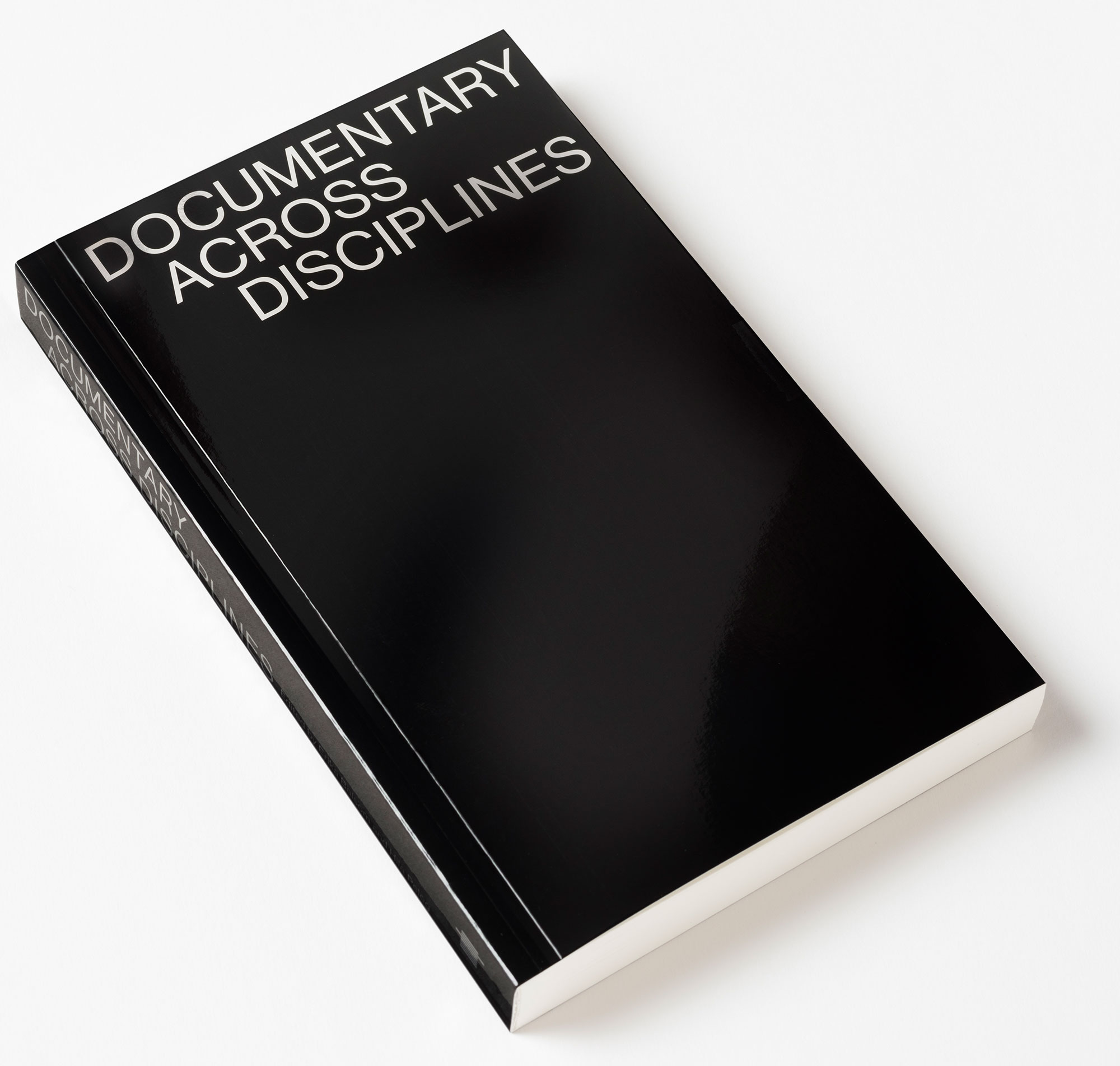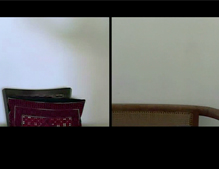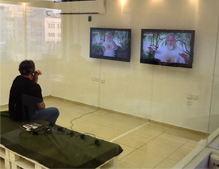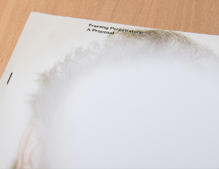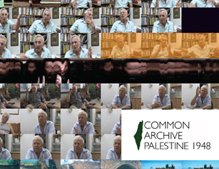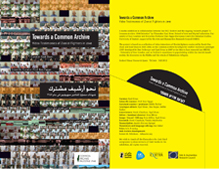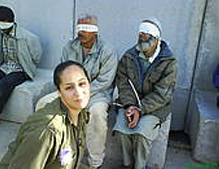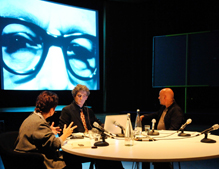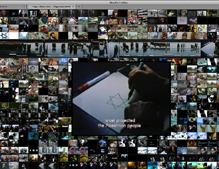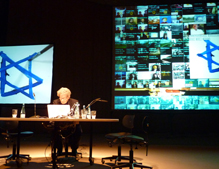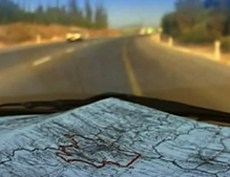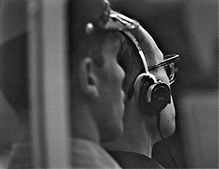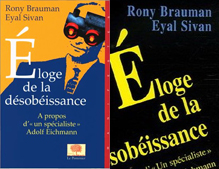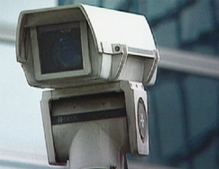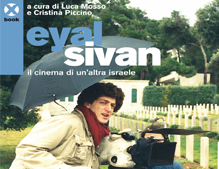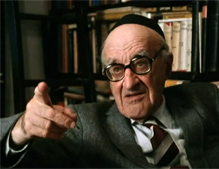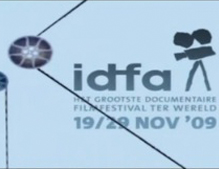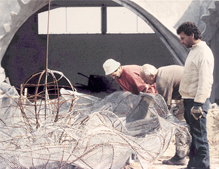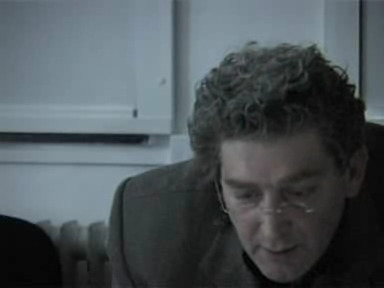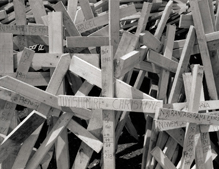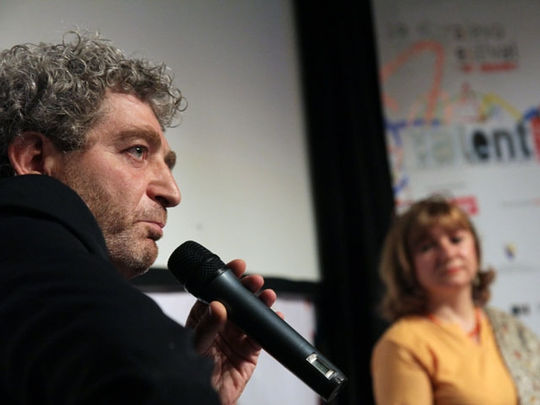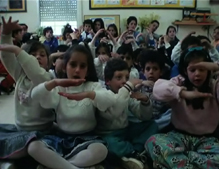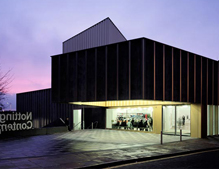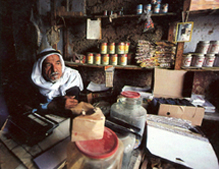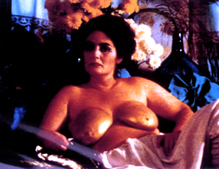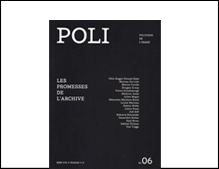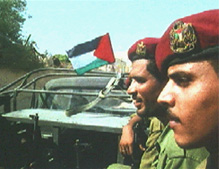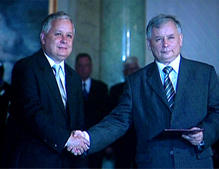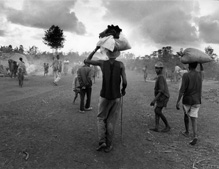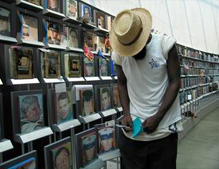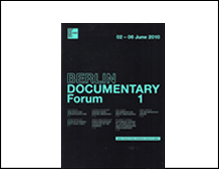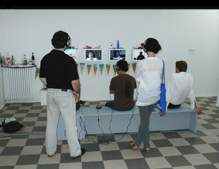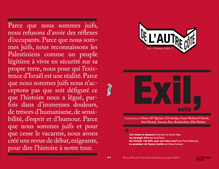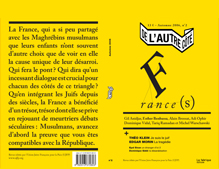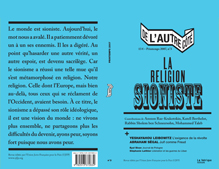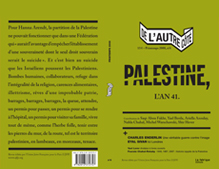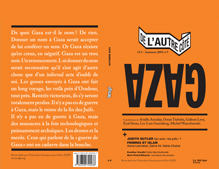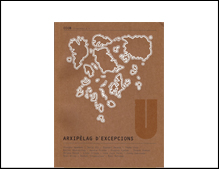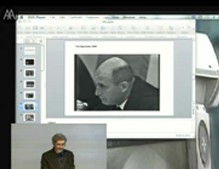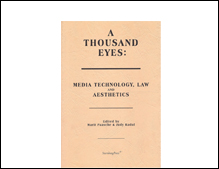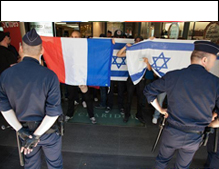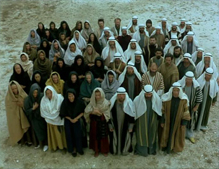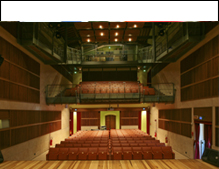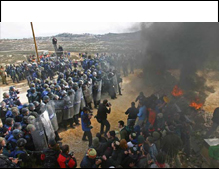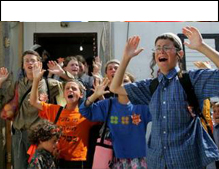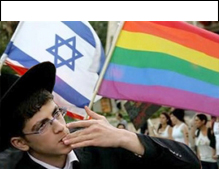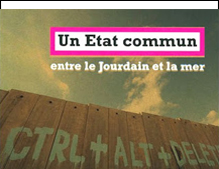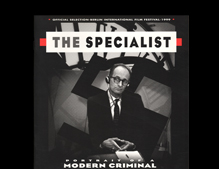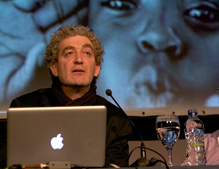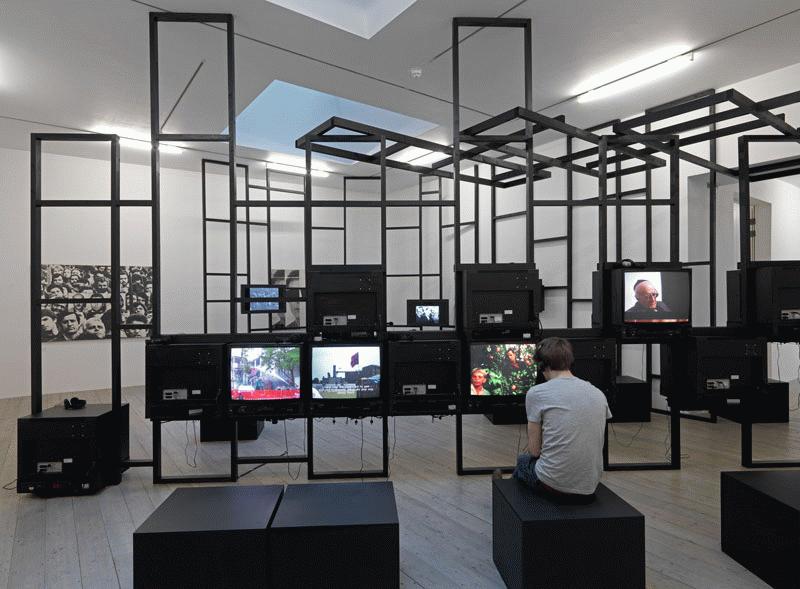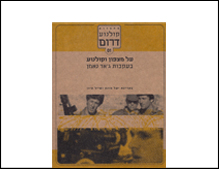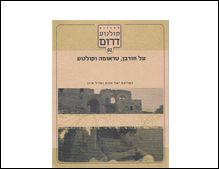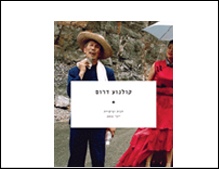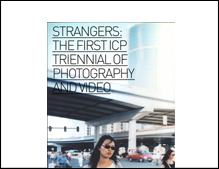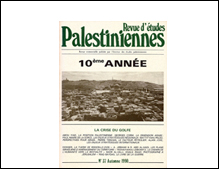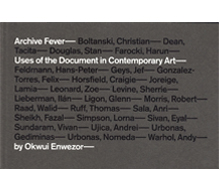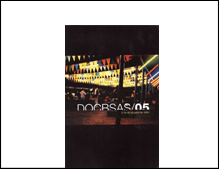-
Proposal for a visual media exhibition
with the participation of students of the Master of Film at the Dutch Film Academy, Amsterdam -
Get my films
Buy DVDs online at www.momento-films.com -
IZKOR
slaves of memory
Documentary film | 1990 | 97 min | color | 16mm | 4:3 | OV Hebrew ST -
Common Archive Palestine 1948
web based cross-reference archive and production platform
www.commonarchives.net/1948 - Project in progress - -
Montage Interdit [forbidden editing]
With professors Ella (Habiba) Shohat and Robert Stam / Berlin Documentary Forum 2 / Haus der Kulturen der Welt / June 2012 -
Route 181
fragments of a journay in Palestine-Israel
Documentary film co-directed with Michel Khleifi | 2003 | 272 min [4.5H] | color | video | 16:9 | OV Arabic, Hebrew ST
-
The Specialist
portrait of a modern criminal
Documentary film | 1999 | co-author Rony Brauman | 128 min | B/W | 4:3 | 35 mm | OV German, Hebrew ST -
Jaffa
the orange's clockwork
Documentary film | 2009 | 88 min | color & B/W | 16:9 | Digital video | OV Arabic, Hebrew, English, French ST
-
Montage Interdit
www.montageinterdit.net
Web-based documentary practice. A production tool, archive and distribution device | project in progress
-
Common State
potential conversation [1]
Documentary film | 2012 | 123 min | color | video | 16:9 split screen | OV Arabic, Hebrew ST -
Towards a common archive
testimonies by Zionist veterans of 1948 war in Palestine
Visual Media exhibition | Zochrot Gallery (Zochrot visual media lab) | Tel-Aviv | October 2012 - January 2013
-
I Love You All
Aus Liebe Zum Volk
Documentary film co-directed with Audrey Maurion | 2004 | 89 minutes | b/w & color | 35mm | OV German, French ST
ROUTE 181, Fragments of a journay in Palestine-Israel 2003
Documentary | 272 minutes | Video | Color | 16:9 anamorphic | Stereo | 2003 / Location : Israel, Palestine / OV : Hebrew, Arabic
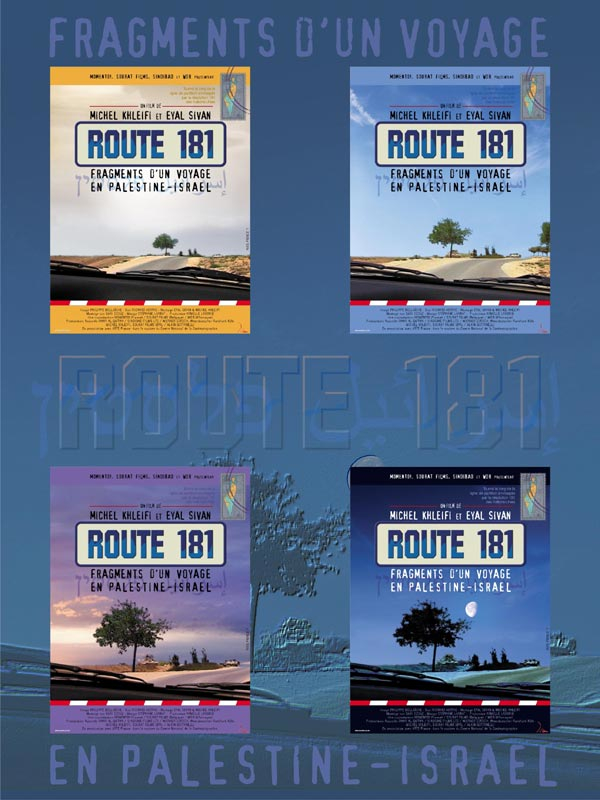
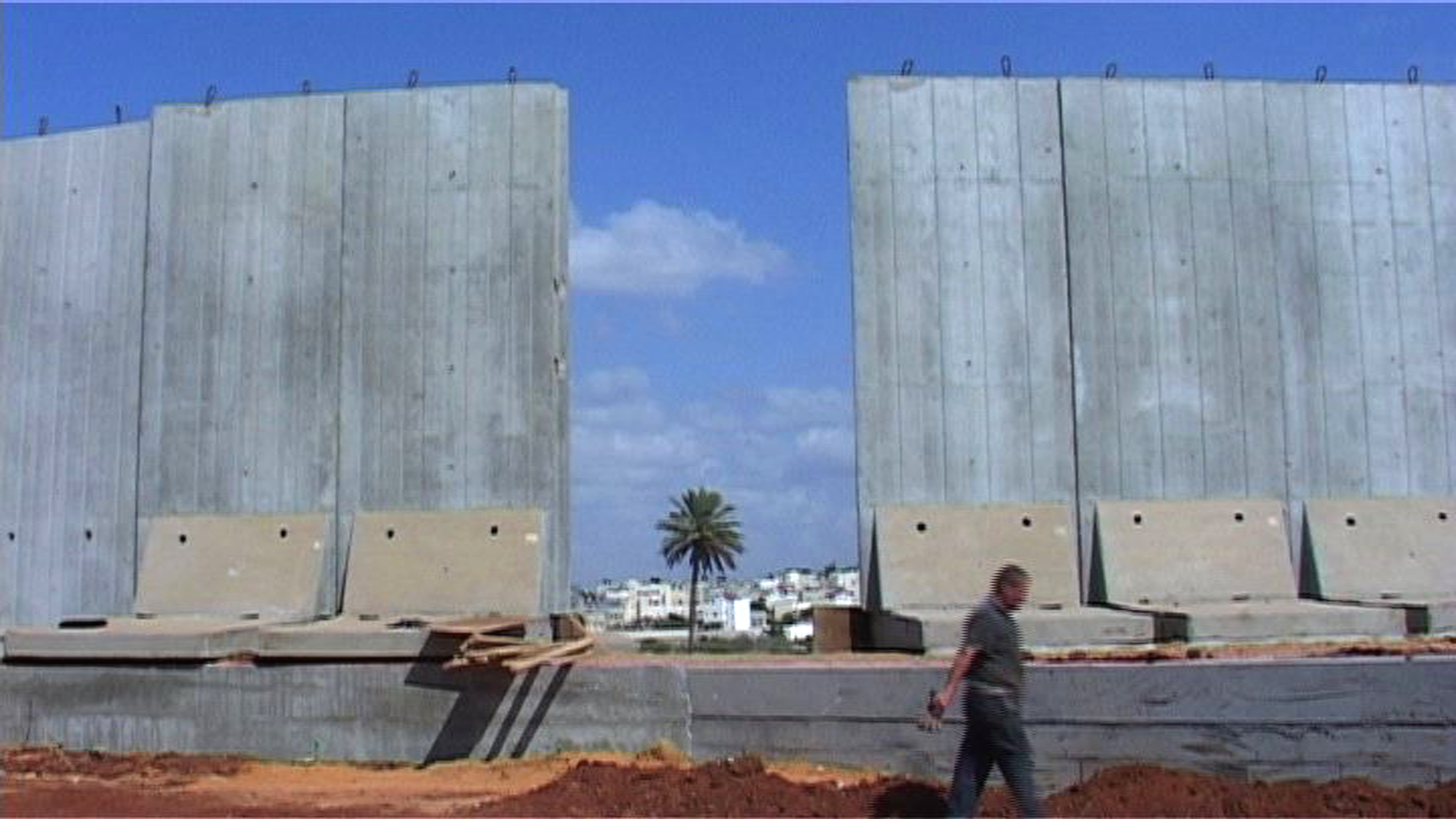
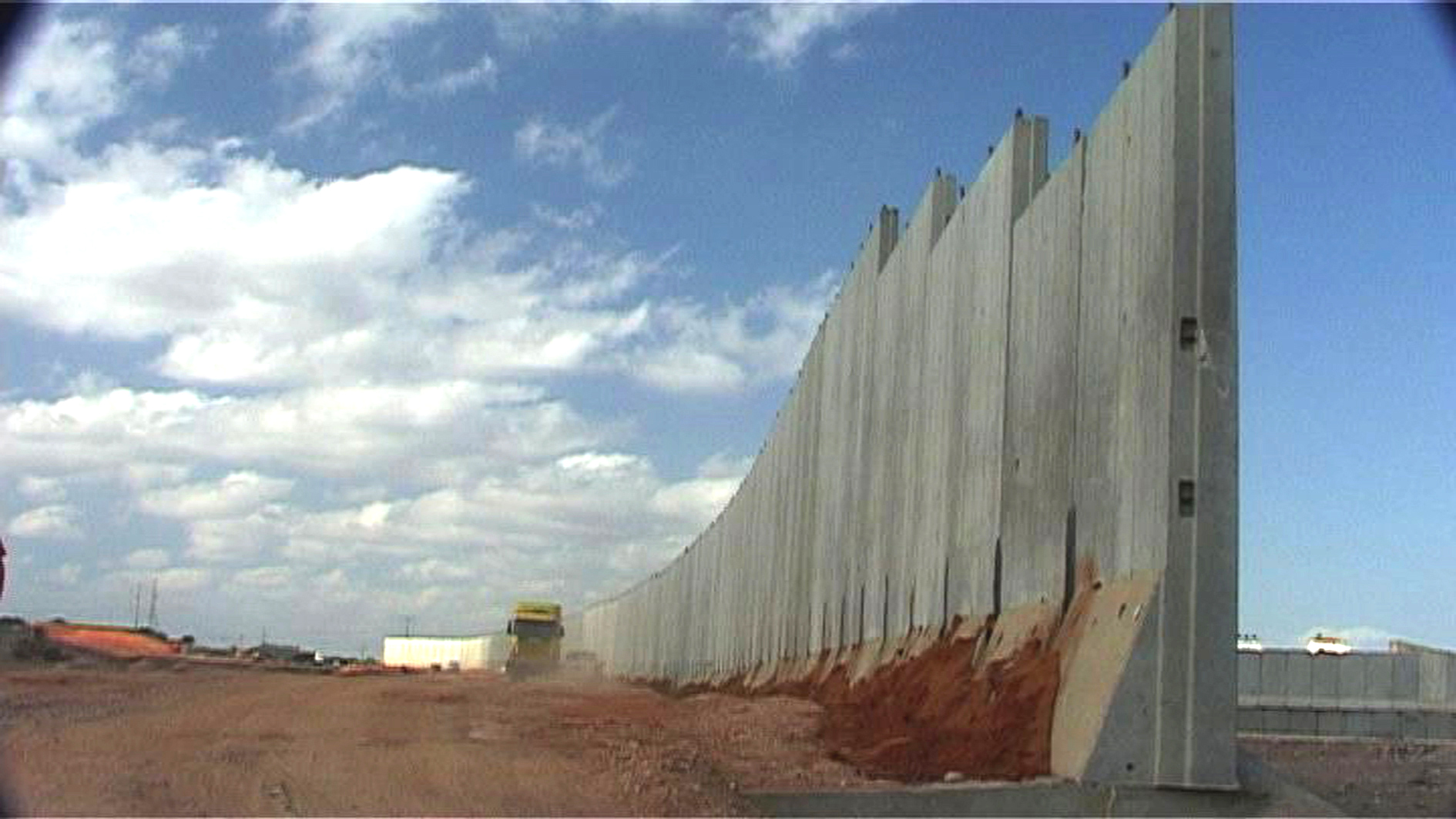
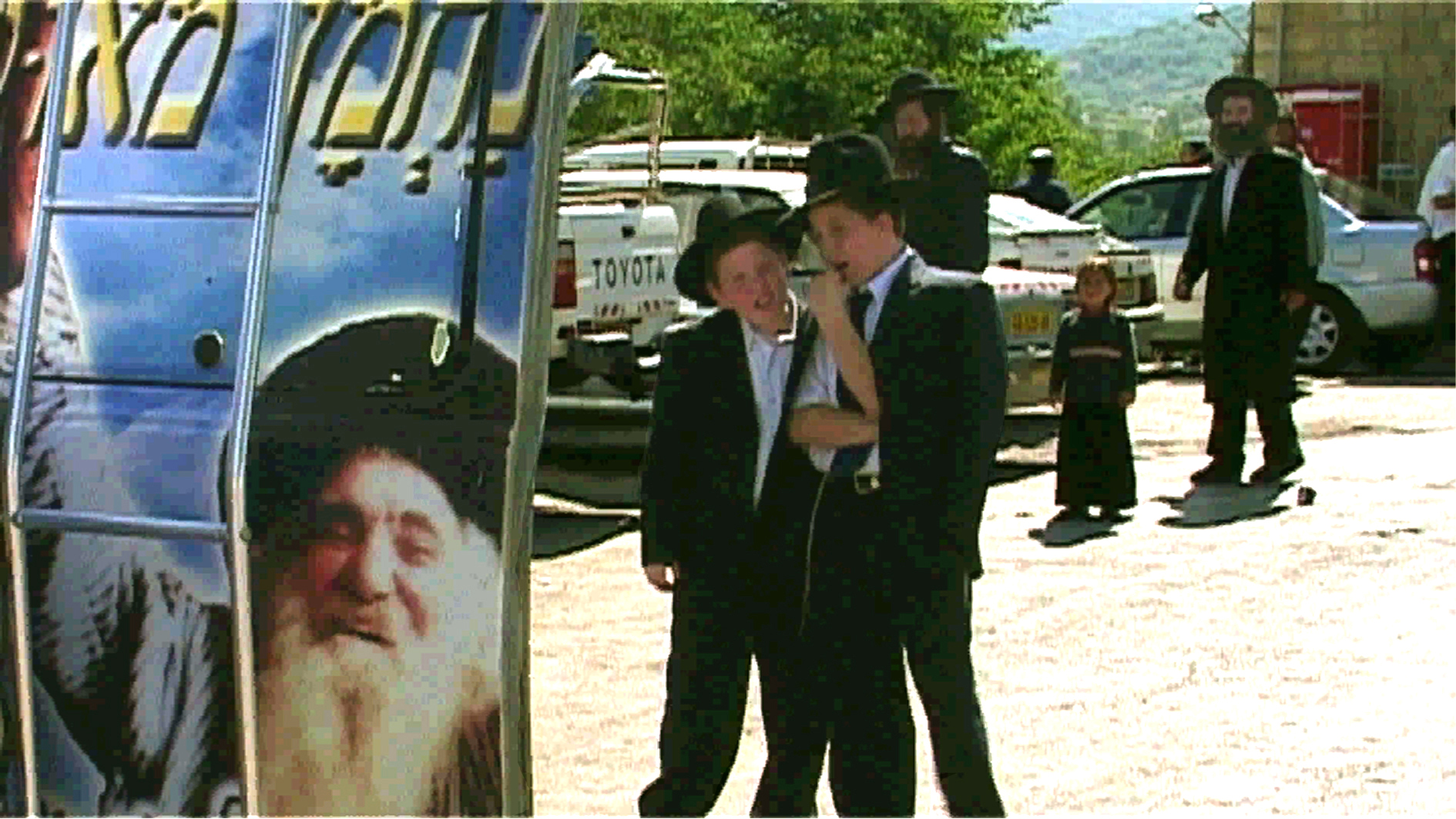
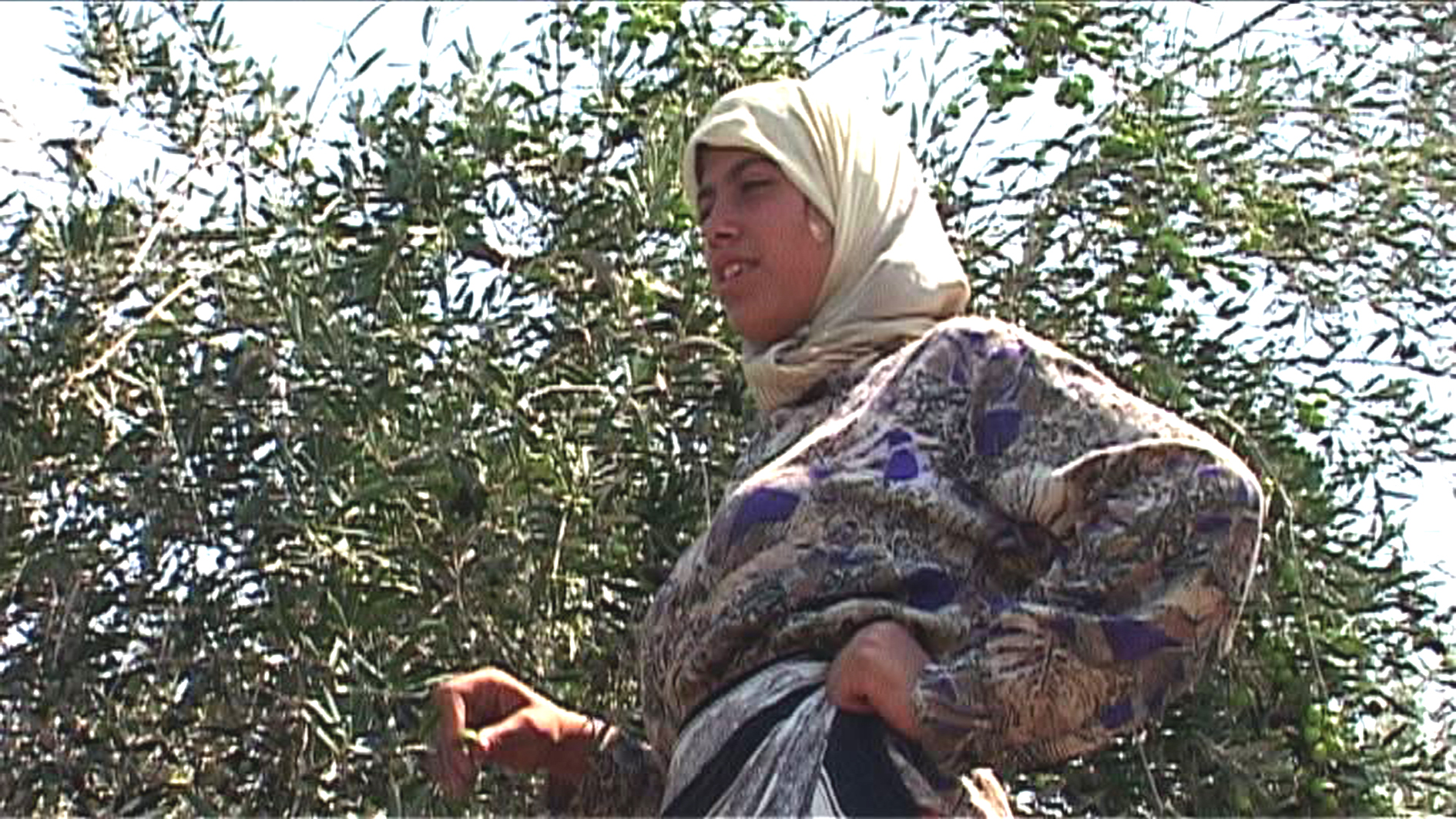
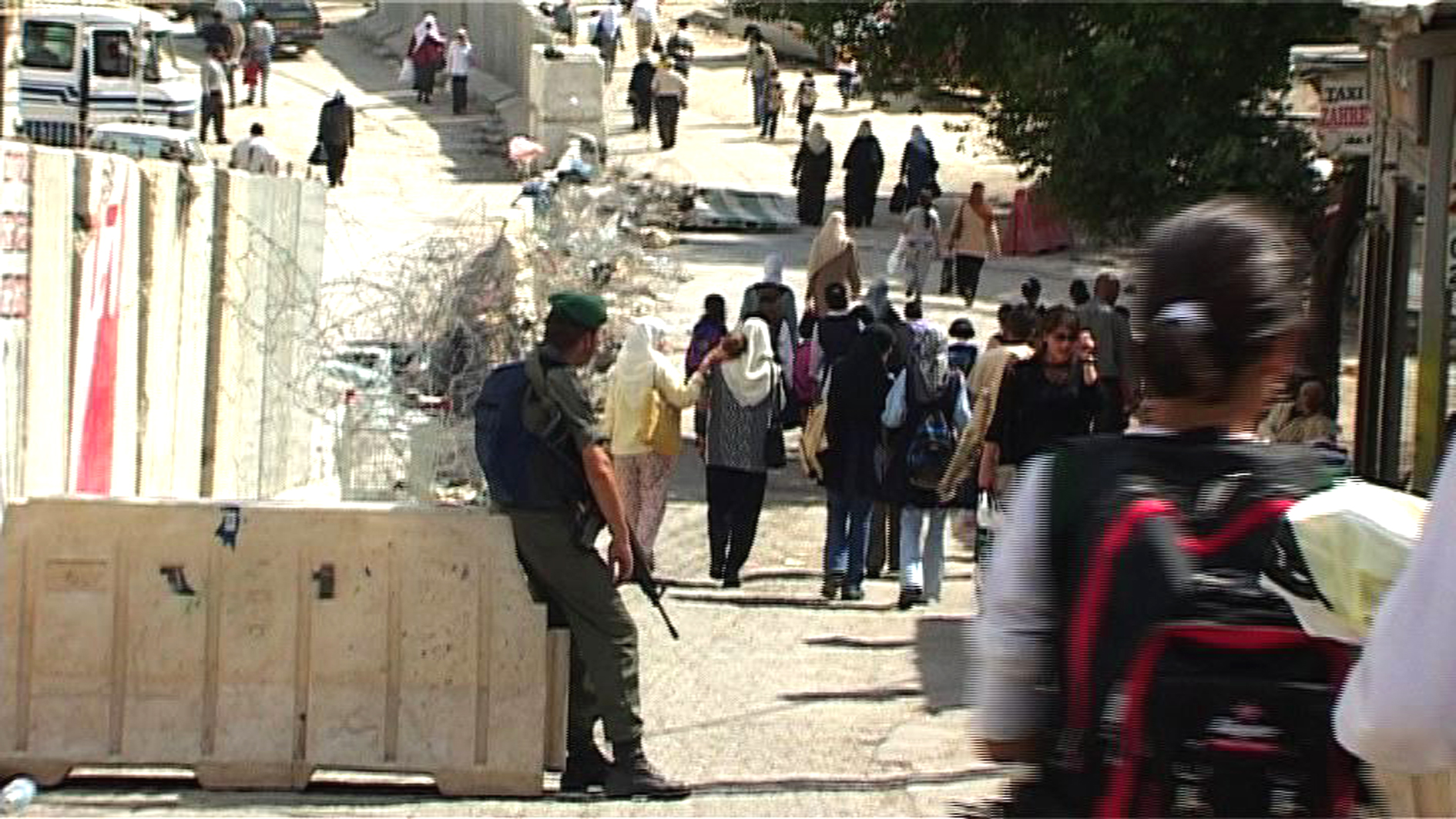
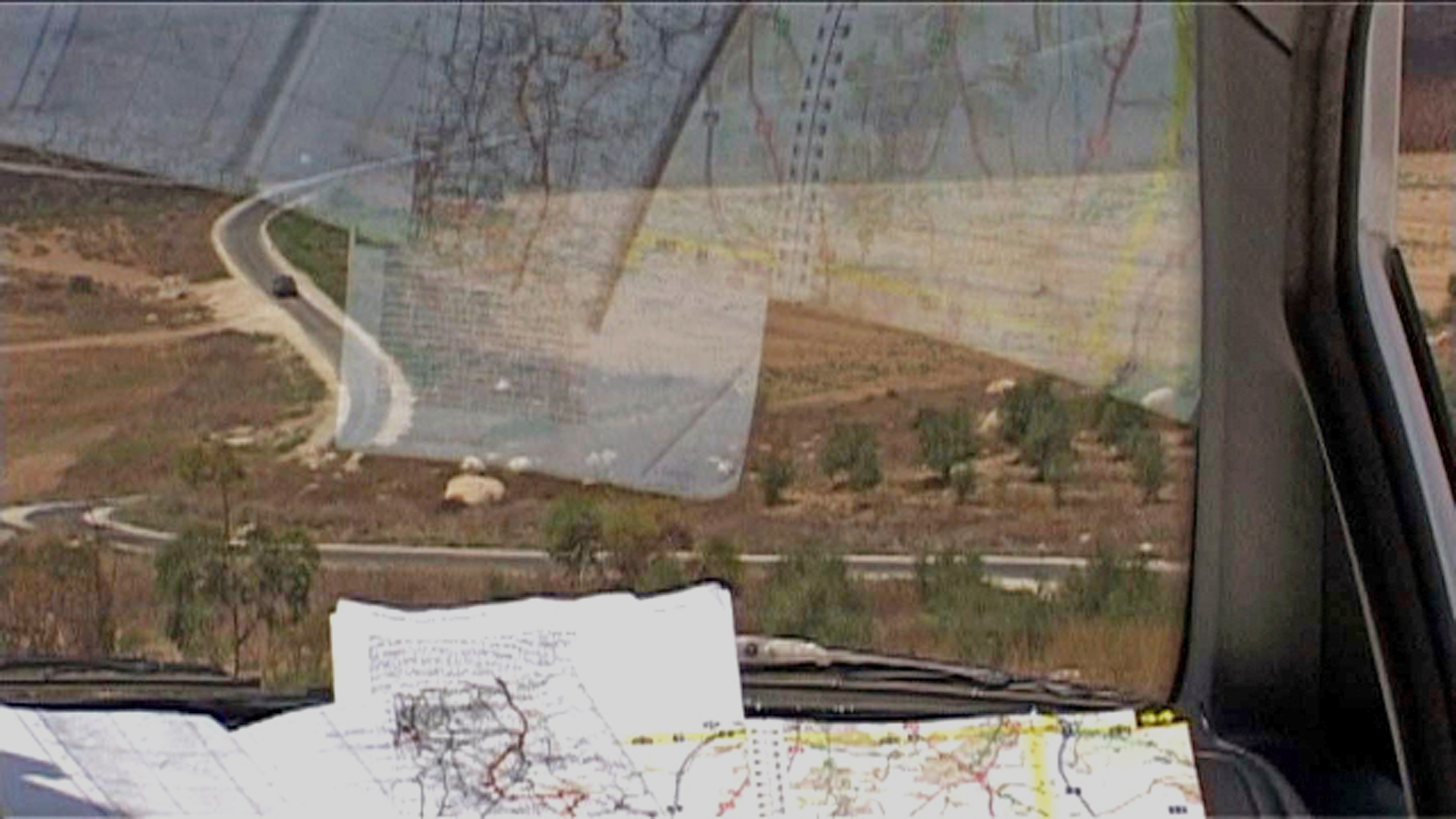

181, offers an unusual vision of the inhabitants of Palestine-Israel, a common vision of an Israeli and a Palestinian.
In the summer of 2002, for two long months, Eyal Sivan and Michel Khleifi travelled together from the south to the north of their country of birth, traced their trajectory on a map and called it Route 181. This virtual line follows the borders outlined in Resolution 181, which was adopted by the United Nations on November 29th 1947 to partition Palestine into two states.
As they travel along this route, they meet women and men, Israeli and Palestinian, young and old, civilians and soldiers, filming them in their everyday lives. Each of these characters has their own way of evoking the frontiers that separate them from their neighbours: concrete, barbed-wire, cynicism, humour, indifference, suspicion, aggression…Frontiers have been built on the hills and in the plains, on mountains and in valleys but above all inside the minds and souls of these two peoples and in the collective unconscious of both societies.
Route 181, Fragments of a Journey in Palestine-Israel, takes us on a disorientating journey across this tiny territory with vast ramifications.

ABOUT THE FILM
Route 181 follows the borders drawn up by UN Resolution 181 which was adopted by the UN on 29th November 1947 to separate Palestine into two states – one Jewish and one Arab. 56% of the territory was attributed to the Jewish minority while 43% was given to the Arab majority, with a small central area given over to international supervision.
Route 181, fragments of a journey in Palestine-Israel is divided into three chapters.
Each chapter traces a part of "route 181" :
THE SOUTH, from the port city of Ashdod to the frontiers of the Gaza Strip.
THE CENTRE, from the Jewish-Arab city of Lod to Jerusalem.
THE NORTH, from Rosh Ha’ayn, near the new separation wall, to the Lebanese borders.
Both filmmakers are convinced that the situation in the Middle East is an ideological/pathological construct made by men, which can therefore be unmade by them.
Their journey was peripatetic and led them to the most arbitrary of encounters.
No appointments were organised beforehand, no personalities contacted, no “official” interlocutors.
Armed only with authorisations to film, they stopped and filmed : anonymous Israelis and Palestinians who speak of their lives, their experiences, their situations, their persoanl memories and understandings of what is happening around them today. These people speak also of tomorrow and what could become of them and their country.
This theoretical border, which was presented as a «solution», led to the outbreak of the first Arab-Israeli war and to a conflict, which remains far from resolved.
55 years later, the journey of these two filmmakers along “route 181” traces a border which never actually existed.
Michel Khleifi and Eyal Sivan wanted to take this joruney together to listen with the ears of the other and to come nearer, each with the help of the other, to those whom fear usually keeps apart.
To understand. To convey what is desired and experienced ; distinguish people’s dreams from political projects ; hear what one wants to forget; listen to the other – this is how this journey in search of a possible peace and a life together has the qualities of an initiation.
In their project notes, the two filmmakers write:
"Despite the tribal allegiances imposed on us, which we reject, and armed with our common experience, we decided to return to our country. By doing so, we wanted to unveil the geographic and mental reality in which the men and women of Palestine-Israel are living today.
"The demarcation line of the Partition Plan for Palestine, drawn up and voted by the UN in 1947, was the starting point of our film. For us, it represented both a documentary challenge and promises of a rich human adventure.
"Along this demarcation line, which does not in fact exist, we wanted to film, in a particular way, men and women, places, all previously unseen. During these chance meetings, we listened together to the varying sounds of people, to their passions and disillusionment. We provoked – in us but also in our interlocutors – a relationship of love in response to a daily reality saturated with danger and overwhelmed by death. The voices of those forgotten by official discourse will we hope, be heard – the voices of those who nonetheless constitute the majority in both societies, those in whose name wars are fought.
"We wished to construct a film which resists the idea that the only thing Israelis and Palestinians can do together is fight wars until they are both driven to oblivion."
—
This film does not have two points-of-view but a common one emanating from two complimentary visions. Whatever the unease which their journey may cause us, Michel Khleifi and Eyal Sivan invite us to follow in their footsteps.
TO THE SOUTH: From Ashdod to Gaza
Ashdod. On the seaside, a building site in progress. Israeli foremen, Chinese workers and Palestinian (Israeli citizen) surveyors are working together.
Gan Yavne is built on the ruins of Barkaa village. A fruit-juice saleswoman is running a small shop on the roadside. She speaks about the right to return. Further on, the manager of a building site refuses to speak about any political issues.
Kiriat Malahi. In his shop, a candy salesman, a Jew from Iraq, remembers his past. He tells us with nostalgia that, in the past, there were a lot of Palestinian villages around.
Shafir. In front of his house, a young high-tech engineer speaks about his neighbours, workers from the Gaza Strip. His father tells the story of this village, built in 1949 by European survivors.
In the museum of the kibboutz Yad Mordechai, an old pioneer tells how the Palestinian inhabitants were expelled towards the Gaza Strip.
Kibboutz Negba. A statue, a Stalinist-looking monument and a scale model of the kibbutz in its beginning remind us of the socialist dream underlying the Zionist project.
In Gaza, the Karni check-point is closed to any civilian access. Some goods trucks have to wait in front of the blocked borderline. No way to cross any of the other checkpoints all around the Gaza Strip.
The "concertina" is manufactured there. It is a special barbed wire with several layers, for which a patent was registered by the factory's owner. It sells very well, in Israel and abroad.
On the border with the Gaza Strip, an Israeli family visits the water reservoir of Nir Am and contemplates the Gaza Strip, which remains closed.
The retired military commandant of the Southern Region during the 1948 war is now the manager of the museum of Nir Am. He explains how the Negev was imposed on the UN Partition commission as a Jewish area. He concludes with his dreams for a tourist development on the frontier.
Beit Hanoun. It is forbidden to film in the military base. But it is allowed to film the electrical fence, which surrounds the Gaza Strip.
Not far from the frontier with Gaza, in the middle of nowhere, there is a white house that a member of Kibbutz Nir Oz wishes to transform into an art gallery.
The night falls on the deserted Erez check-point.
This evening, the Herzl House is rented out for the celebration of a great wedding.
THE CENTRE: From Lod City to the Jerusalem area
In the Centre for New Immigrants in Lod, Russian musicians play melodies from Eastern Europe to greet new immigrants just arrived from Ethiopia who seem visibly perplexed.
In front of the town hall, a group of Jews and Arabs from the movement "Living Together" [ta’yoush] demonstrate against the demolition of houses planned for the Arab districts of the city. At the same time, the local council discusses these demolitions.
In the quarter called "ghetto", a woman who was political prisoner for years and her Jewish neighbour live side by side. In his hairdressing salon, the old barber speaks about the expulsion of the Palestinian inhabitants of Lod (Lydd), a big Arab city before 1948.
On the way to the kibbutz Geser, a Jewish man from Russia regrets to have immigrated in Promised Land. Further on, a Bedouin leading his herd dreams of joining the Israeli army.
In Kibbutz Geser, a group of American Protestants from Kansas plant a few olive-trees as a solidarity gesture with Israel. The ceremony is conducted by a woman rabbi and her husband, both of them American Jews.
On the way to Jerusalem, the ruins of the Palestinian villages are visible.
In Kfar Binoun, a sculptor, son of Holocaust survivors, speaks about the ordeal suffered by his mother during the war. For him, building his personal heaven for himself and his family is a kind of revenge.
In Hulda, a guide of the Jewish National Fund welcomes the visitors to Herzl House in Hulda. Like all the Jewish villages built on the sides of the road to Jerusalem, Hulda was built on the ruins of a Palestinian village.
There are several military checkpoints on the road approaching Jerusalem.
Kalandia is the biggest military checkpoint between Jerusalem and Ramallah. This is also an opportunity to discuss with the duty soldiers about the importance of being polite.
In a military tribunal, a human rights Israeli lawyer defends young Palestinians accused of being suicide bombers. The court is under high surveillance. The families of the defendants are here. When the mothers try to kiss their sons, the young soldiers immediately stop them. It is forbidden to touch the defendants.
In Abou Dis, the big concrete wall cuts through the town. A Palestinian geographer explains that the settlement-building all around Jerusalem is part of a global colonisation strategy.
Several houses of suicide bombers’ families were dynamited during the night by the Israeli army. Then, entire families find themselves out on the street. They walk through the ruins of their houses expressing their anger.
Since a suicide-attack in Jerusalem was just announced, the zone is totally closed. At the Al-Ram check-point, a soldier spontaneously goes to the camera to give his explanations, which he wants to be transmitted all over the world.
Ramallah is totally empty, under curfew. The Israeli army is there, controlling any movement. From his tank, the commandant speaks about literature and philosophy.
The road between Bethleem and Beit Jala is closed. The guests of a Palestinian wedding that is to be celebrated there have to use small tracks and climb over piles of earth. But the military occupation is unable to prevent the wedding party from taking place.
TO THE NORTH: From the city of Rosh A’aiyn to the Lebanese border
In Rosh A'Aiyn, on the ruins of Majdal Sadek, a Jewish Yemenite jogger runs with his dog. There, he denies totally the destruction of any village in 1948.
The highway to the North is all new, like the separation wall built on its side.
Near Kalkylia, in a small archaeological place, the workers are Palestinian and the archaeologists Israeli. Next to it, workers are building the wall. They are Arab, Turkish-Bulgarian, Uzbek...
Surrounded by Israeli positions, the city of Kalkylia is under curfew.
In Tulkarem, soldiers stop a group of demonstrators from the Jewish-Arabic movement Ta’ayoush (living together). They have to cross the hills to bring food to the inhabitants of the Palestinian city under siege. Access is impossible.
In Bir Sika, inspectors of the Rabbinate inspect the harvest and ensure that it is kosher. The owner explains how he moved the borders of his land….
In the region of Emek Ysrael, at night fall, fighter planes come back to their military air base, in the middle of the Jezreel Valley. A jogger from a neighboring kibbutz thinks that the current settlements took the place of the yesterday's kibbutzim.
In kibbutz Yifat, employees of the Pioneer Settlement Museum perform a play which recounts the story of the first pioneers in front of young and old visitors.
The town of Lubia is in ruins. A group of Israeli teenagers, protected by an armed guard, walk where the town once stood.
The manager of the Museum of Sejera, an immigrant from the United Kingdom, describes his personal story as a continuation of the pioneers', who installed themselves here, at the beginning of the 20th century.
In Tura'An, an old Palestinian woman, surrounded by her grandchildren, speaks about her expulsion from Sejera, only 4 kilometres from there, where she used to live until 1948.
Next to the war memorial in Nujeidat, a group of Israeli Arab pupils discuss questions of identity.
An old man we meet at the entrance of kibbutz Farud, speaks in detail and without hesitation or compunction about how he took part in the expulsion of the Arab inhabitants of the North of Palestine during the war. This operation was called "Operation Broom".
In the village of Kfar Shammaï, a girl reads an inscription on a wall: "We had a dream. Now we have a maybe." A Jewish woman from Morocco explains how she took part, when she was a teenager, in the illegal immigration of Moroccan Jews.
Meron is a religious place. It is always bedlam. Everything can be bought, everything sold. In a mixture of deafening sounds, young religious men dance together.
In Shefer. He is a Jew from Morocco. She is a Jew from Tunisia. Both of them live together in the nostalgia of their countries of origin. “Our youngest son died during the Lebanon War” she tells us. Beside it, they are sure that Jewish and Arab peoples can live peacefully together, like it was in the past.
The sun falls on the barbed wire of the frontier with Lebanon.
© momento! [FR] l SOURAT FILMS [BE] l WDR [ALL]
ROUTE 181, FRAGMENTS OF A JOURNEY IN PALESTINE-ISRAEL
272 minutes | DV | Colour | 16:9 anamorphic | Stereo | 2003
Location : Israel, Palestine
OV : Hebrew, Arabic
Sub-titles : French, English, Italian, Spanish, German, Hebrew, Arabic
A FILM WRITTEN, DIRECTED AND PRODUCED BY
Eyal Sivan & Michel Khleifi
PRODUCTION
ARMELLE LABORIE
CAMERA
Philippe Bellaïche
SOUND
Richard Verthé
EDITING
Sari Ezouz
Eyal Sivan
Michel Khleifi
SOUND EDITOR
SARI EZOUZ
SOUND DUBBING
STÉPHANE LARRAT
CO-PRODUCERS
OMAR AL-QATTAN, SINDIBAD FILMS LTD
WERNER DÜTSCH, Westdeutscher Rundfunk Köln
MICHEL KHLEIFI, SOURAT FILMS SPRL
ALAIN BOTTARELLI
IN ASSOCIATION WITH
ARTE France
WITH SUPPORT FROM
Centre National de la Cinématographie
© momento! [FR] l SOURAT FILMS [BE] l WDR [ALL]
• HUMAN RIGHTS FESTIVAL AWARD Paris, France, 2004
• MAYOR AWARD, INTERNATIONAL DOCUMENTARY FILM FESTIVAL Yamagata, Japan, 2005
FESTIVALS SELECTION
--------------------------------------------------------------------------------------------------------------------------------------
• Festival du Monde Arabe, Montréal, 2003
• Festival of Arab, Iranian and South Asian Films, New-York, 2003
• Festival Cinéma du Réel, Paris 2004
• Festival de Rabat, 2004
• Festival Manifesta, San Sebastian, 2004
• Festival de Carthage, 2004
• Festival de Haïfa, 2004
• Festival de San Fransisco, 2004
• Festival de Washington, 2004
• Festival “Filmer à tout prix”, Bruxelles 2004
• Dokma Festival, Slovénie, 2004
• Festival de Singapour, 2005
• Festival de Philadelphie, 2005
• Festival International de Jeonju, Seoul, 2005
06/23/2008 - "BHL soutient Finkielkraut, â�¨accusé de diffamation" (nouvelobs.com)
09/08/2007 - "The Barber Trial: Sivan vs. Finkielkraut" by Thomas Keenan and Eyal Weizman (Cabinet, at Documenta 12)
06/29/2006 - "France: Court rejects lawsuit against Finkielkraut", by Merav Yudilovich (ynet.com)
08/04/2005 - "Roads to Somewhere: Paradise Now and Route 181" by Richard Porton (CinemaScope)
05/01/2005 - "Scènes proches orientales" by Joëlle Marelli (Vacarmes, printemps 2005)
02/01/2005 - "Road To Perdition" by Harlan Jacobson (Film Comment)
01/01/2005 - "Greater Palestine: Matching Demography, Geography, and Heart" by Sharif S. Elmusa (Political Science Department, The American University in Cairo)
01/01/2005 - "Talk is cheap: some notes on freedom of speech and the ethics of listening in Route 181 by Michel Khleifi and Eyal Sivan" by Uriel Orlow
11/12/2004 - ×�×�פש ×�×�×�ס×�×� ×�×�-×�ר×�ר ×�×�×�× ×� - NRG
09/22/2004 - “De la Route 181 à la Feuille de route” by Marianne Dautrey (Charlie Hebdo)
09/01/2004 - "Route 181 de Sivan et Khleifi : un film de propagande animé par la haine d'Israël" by Anny Dayan-Rosenman (L'Arche)
07/13/2004 - "Na(rra)zioni parallele" by Simon Levis Sullam (Il Manifesto)
07/01/2004 - "Journey toward a Route in Common" by Bashir Abu-Manneh (Middle East Report)
07/01/2004 - "Psychanalyse collective" by Dominique Vidal (Le Monde Diplomatique)
06/30/2004 - "Route 181, un divan public" by Christophe Ayad (Libération)
06/29/2004 - "Retour sur la "Route 181" by Geneviève Welcomme (La Croix)
06/13/2004 - "Route 181: Fragments of a Journey in Palestine-Israel" by Maureen Clare Murphy (The Electronic Intifada)
05/01/2004 - "Route 181, Palestina-Israele" by Sergio Di Girogi (Lo Straniero)
03/08/2004 - "Cinéma Quand le réel s’invite", by Emile Breton (Humanité)
03/01/2004 - "De la vraie nature du nationalisme", by Philippe Simon (Cinergie – revue du cinéma belge)
03/01/2004 - "Obscurantisme et censure sur la Route 181" by Antonia Naim
11/28/2003 - “Découper la région en deux Etats est un leurre” (Le Matin, Switzerland)
11/25/2003 - "Shoah politique et cinématographique" by Menahem Macina (Debriefing.org)
11/01/2003 - "Beautiful Dreamers. Unsettled Returns: A Screening and Dialogue with Michel Khleifi and Eyal Sivan" by Richard Fung (Fuse Magazine, Volume 26, Number 4)
09/26/2002 - "Le mur de la honte version Sharon" by Slimane Zeghidour (La vie)

